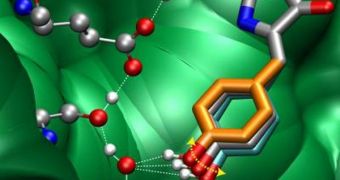The discovery and development of the green fluorescent protein (GFP), a 238-amino-acid structure that is able to emit fluorescent light when blue light is applied on it, has won scientists Martin Chalfie, Osamu Shimomura, and Roger Y. Tsien the 2008 Nobel Prize in Chemistry. Since then, numerous investigators have spent countless hours in the labs, trying to determine precisely how the protein functions, and, most importantly, the changes it undergoes as it moves through target organisms. Advancements in genetics have allowed researchers to insert it into the cells of many types of bacteria, which helped determine some of the processes going on inside.
One of the most difficult works is being conducted at the University of California in Berkeley (UCB), where scientists are struggling to determine the structural changes that GFP undergoes when it fluoresces. The only way to do that is with femtosecond lasers that emit extremely short pulses of light. A femtosecond is one quadrillionth, or one billionth of one millionth, of a second. This is the only type of laser that can freeze the atoms in the target, which vibrate about 100 trillion times per seconds, or 100,000 times every nanosecond.
The observation method the team employs is actually a derivative work of normal laser studies, called femtosecond stimulated Raman spectroscopy. It allows the scientists to freeze the atoms inside the protein, which in turn reveals all the intricate and ultra-fast changes that take place in GFP when it enters the chemical reactions that lead to triggering its fluorescence. While the protein has already been genetically engineered to produce various types of light, and to respond to different wavelengths, scientists want to reproduce its working mechanism so that they could use it in future solar cells, and other photovoltaic materials.
“If you want to understand how a reaction occurs, you need to look at it as the chemical bonds change structure, which occurs over tens of femtoseconds. With a femtosecond laser and Raman spectroscopy, we can see all the steps in the proton transfer reaction in the excited state of GFP,” the Dean of the UCB College of Chemistry, Richard Mathies, says. The expert is also a professor of chemistry at the university.
“A lot of people have studied green fluorescent protein for many years and found out that proton transfer in the excited state emits a very efficient flash – for every 100 blue photons going in, 80 green ones come out. This experiment shows why it is so efficient with vivid atomistic details,” UCB Department of Chemistry postdoctoral fellow Chong Fang adds. He has also been the first author of the new study detailing the finds, which appears on the cover of the November 12 issue of the respected scientific journal Nature.

 14 DAY TRIAL //
14 DAY TRIAL //